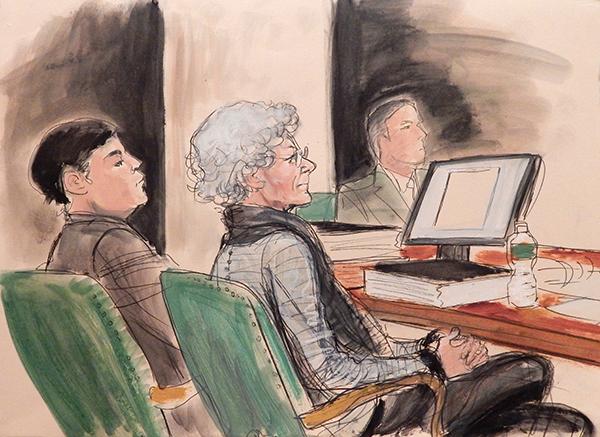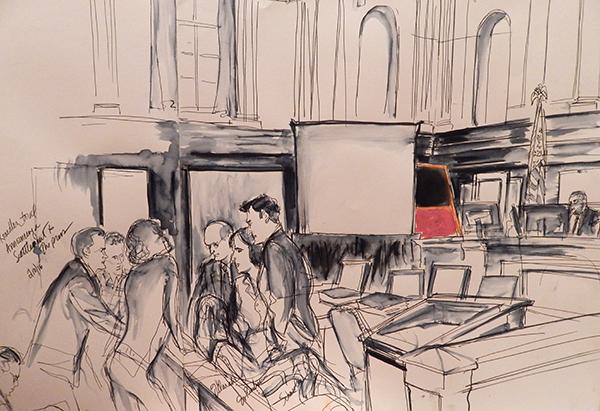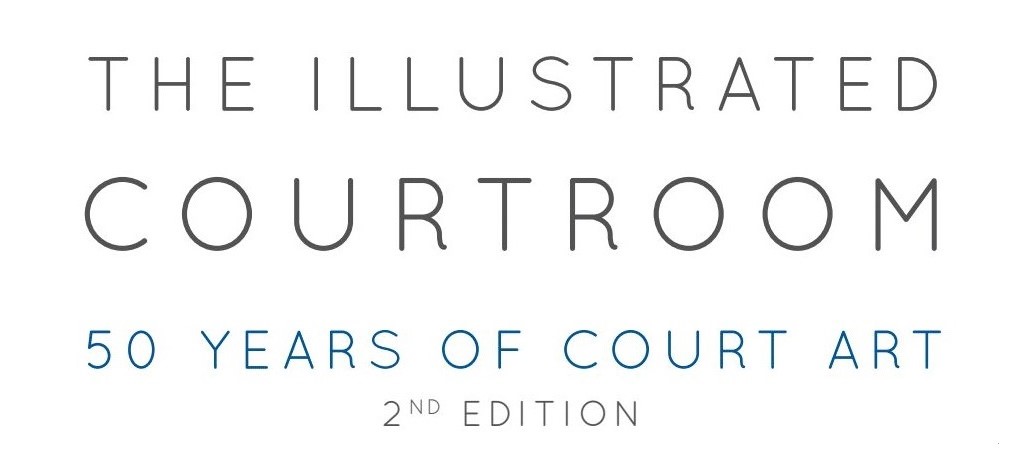DOWNTOWN POST: WORLD TRADE GALLERY EXHIBIT CHRONICLES THE KNOEDLER GALLERY ART FRAUD TRIAL THAT UPENDED THE ART WORLD
Link:
 |
| Domenico De Sole, chairman of Sotheby's board of directors, on the witness stand at the trial in which he accused Knoedler Gallery of selling him a fake Rothko painting for $8.3 million. (Illustrations: © Elizabeth Williams) |
Psst. Want to buy the Brooklyn Bridge? No? Then how about a painting by Mark Rothko? So few come to market. You haven't seen this before because it previously belonged to a Swiss collector who bought it directly from the artist. Now his son wants to sell it but wishes to remain anonymous.
Minus the Brooklyn Bridge, that was roughly the dialogue that roped in some hugely wealthy art collectors who plunked down millions of dollars at the prestigious Knoedler Gallery to buy paintings by Rothko, Richard Diebenkorn, Robert Motherwell, Jackson Pollock, Willem de Kooning, Clyfford Still and Barnett Newman - all of them fakes.
In a trial that started on Jan. 25, 2016 and ended on Feb. 10, Domenico and Eleanore de Sole, two of the defrauded collectors, sued the Knoedler Gallery, its former director, Ann Freedman, and the gallery's holding company, 8-31 Holdings, for $25 million. In 2004, they had bought a bogus Rothko for $8.3 million and wanted their money back, plus damages.
The trial took place in Manhattan's United States District Court, 40 Centre St., in front of Judge Paul G. Gardephe and a 10-person jury.
In the absence of cameras, courtroom artists Elizabeth Williams and Victor Juhasz recorded the proceedings. Their drawings are now on exhibit and for sale at the World Trade Gallery, 120 Broadway, through Feb. 27.
"This was the largest art fraud trial of all time," said Williams. "It rocked the art world."
Knoedler took in roughly $70 million for fraudulent sales that started in 1994, Williams explained. A woman named Glafira Rosales appeared at Knoedler with a cache of Abstract Expressionist paintings that she sold to the gallery for a fraction of what they would normally cost. The first batch were a couple of Diebenkorns.
In February 1994, gallery director Freedman asked John Elderfield, chief curator of painting and sculpture at the Museum of Modern Art, and Diebenkorn's widow and daughter to look at the paintings. All of them expressed doubts to Freedman about their authenticity.
But that didn't stop Freedman from selling the Diebenkorns and the other paintings that Rosales brought to her. She assembled lists of people who had supposedly authenticated the paintings. During the trial, many of them testified that they had never authenticated anything or consented to have their names used.
"The crux of the trial was whether or not Ann Freedman knew the art was fake," said Williams.
Judge Gardephe believes that she knew. An article in The New York Times (Jan. 24, 2016) quoted him as saying that there was "ample circumstantial evidence demonstrating that Freedman acted with fraudulent intent and understood that the Rosales paintings were not authentic."
In fact, the paintings were created by Pei Shen Qian, a Chinese immigrant living in Flushing, Queens. Williams said that he was working as a street artist in SoHo when Rosales met him.
Qian was indicted on charges of conspiracy, fraud and making false statements and has fled to China. He has said that he didn't know that his work was being sold as authentic. He was paid a few hundred dollars to as much as $9,000 for work that Knoedler subsequently sold for millions.
Freedman has been sued but not indicted. Rosales pleaded guilty to federal tax evasion and money
 |
| Ann Freedman, former director of the Knoedler Gallery. |
The party came to an end in 2011. During a divorce settlement, Pierre La Grange, a London hedge fund executive, needed to sell the Jackson Pollock painting that he had bought from Knoedler. He took it to Christie's and Sotheby's to have it appraised and learned that it was fake. It used pigments that weren't commercially available until 14 years after Pollock's death.
Knoedler, founded in 1846, was the oldest art gallery in New York City. When La Grange sued Knoedler in November 2011, it shut down the next day.
That's what tipped off Domenico and Eleanore de Sole that their Rothko might also be a fake.
To date, the scandal has led to 10 lawsuits. Five were settled out of court. The de Soles' suit was the first to go to trial. The four others that are pending are not likely to be heard for at least a year.
When the de Soles had their Rothko painting displayed in their South Carolina home, they had it encased in expensive glass and protected by an alarm system. On Jan. 27, when the "Rothko" appeared in the courtroom, it was handled "much in the way that one might deal with an empty pizza box," according to an account in Art News (Feb. 1, 2016).
Domenico de Sole said that the painting was "worthless."
The de Soles' lawsuit was settled right before Michael Armand Hammer, grandson of industrialist Armand Hammer, founder of the Knoedler Gallery, was supposed to take the witness stand.
The de Soles said they were happy with the settlement.
Liz Williams said that she enjoyed being back in Courtroom 318 at the Thurgood Marshall Courthouse, which is where the trial was held. "It's one of three ceremonial courtrooms in that courthouse," she explained. "They have marble walls and wood. That's where the big trials take place."
She recalled having been in that courtroom in 1986 when she sketched Donald Trump, who was testifying on behalf of the U.S. Football League against the National Football League.
Her drawing of Trump on the witness stand is among the works now for sale at the World Trade Gallery. The drawings range in price from $1,200 to $3,800. All of them are authentic.
- Terese Loeb Kreuzer
The World Trade Gallery is at 120 Broadway (entrance on Cedar Street). It is open daily. For more information, click here. |
| Lawyers and the press with the "Rothko" painting after the de Soles' trial was settled. |


No comments:
Post a Comment